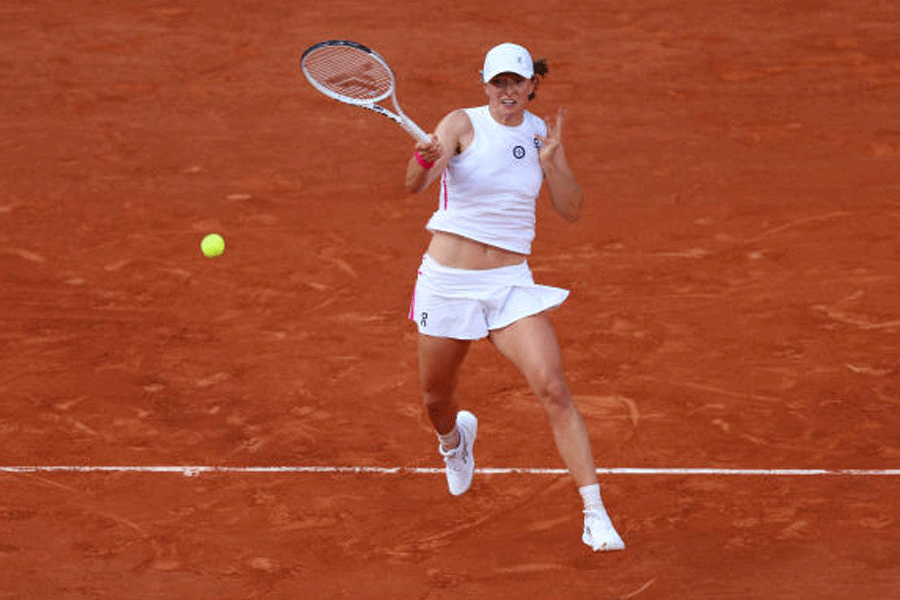There is a woman in professional tennis who has long sparked a wistfulness among her fellow players.
They rave about her buttery smooth strokes, her deceptive power, that sublime balance and the seemingly effortless movement that make it so easy to imagine her running the offence on her nation’s basketball team, or playing centre midfield on its football team.
If Karolina Muchova can ever stay healthy, they say, watch out.
Noted.
Muchova, a 26-year-old from the Czech Republic, will take on Iga Swiatek, the world No. 1, in a tantalising French Open final on Saturday after upsetting Aryna Sabalenka of Belarus 7-6(5), 6-7(5), 7-5.
Every bit of Muchova’s repertoire was there on a steamy afternoon at Roland Garros. Lunging returns that floated down just inside the baseline.
Banging forehands followed by dying drop shots. The ability to filet the hardest of Sabalenka’s forehands, which come off her racquet as hard as any shot in women’s tennis, with cutting volleys that showed off the unteachable touch of a billiards shark.
She needed it all — and some guts, too.
A major final is where so many have thought Muchova should have been for so long. A late-ish bloomer by the standards of the Czech Republic, Muchova began battling injuries in her late teens, when a growth spurt pushed her height to 5-foot-11 but also spurred back and knee troubles.
She overcame those to make the quarter finals of Wimbledon in 2019 and the semi-finals of the Australian Open in 2021. But a series of nagging injuries sent Muchova spiraling to 235th in the world rankings, far from her peak of 19th in 2021.
“Many lows, I would say, from one injury to another,” she said after her win Thursday. “Some doctors told me, you know, maybe you’ll not do sport anymore.”
She tried to stay positive, though, grinding through one rehabilitation after another even as she struggled through small tournaments.
“Some doctors told me, you know, maybe you’ll not do sport anymore,” she said after her win on Thursday
Things happen quickly in tennis. She entered the French Open ranked 43rd. She beat the eighth-seeded Maria Sakkari in the first round and dropped just one set in her first five matches. Just like that she was playing the tightest of third sets in front of 15,000 people in a grand slam semi-final.
It may very well get crazy once more on Saturday against Swiatek, who won this tournament in 2020 and 2022 and has won 13 consecutive matches at Roland Garros.
Swiatek, who turned 22 last week, has enjoyed a career that has been the polar opposite of Muchova’s. She won her first grand slam title when she was 19 years old, and she became the world No. 1 at 20 in April 2022.
And while Swiatek initially played the kind of varied, all-court style that has garnered Muchova the lusty praise from tennis aesthetes, she largely abandoned it early last year in favour of a simpler, more aggressive approach built around taking every opportunity to blast her forehand and pound opponents off the court.
It works. Swiatek can be downright lethal, finishing so many sets with scores of 6-0 (a “bagel” in tennis parlance) or 6-1 (a “breadstick”) that Twitter often lights up with chatter about “Iga’s Bakery” when she is on the court.
If contrasts in styles are the sauce of great tennis matchups, then the final between Muchova and Swiatek holds the potential to be special. Swiatek will look to dig in and bang away. Muchova will look to use every weapon she has, keeping Swiatek guessing about what will come off her racquet next.
The two have played just once, four years ago. Muchova won that match on clay in front of a home crowd in Prague. The two have practiced together many times since then, said Swiatek, who counts herself among the Muchova faithful.
“She can do anything,” Swiatek said.
Their one match may be a sample size too small for drawing any conclusions, but this stat may be more telling: Muchova has played five matches against players ranked in the top three, and she has won every time.
“It just shows me that I can play against them,” she said Thursday. Indeed she can. Her competitors have known that for a while now.
New York Times News Service











